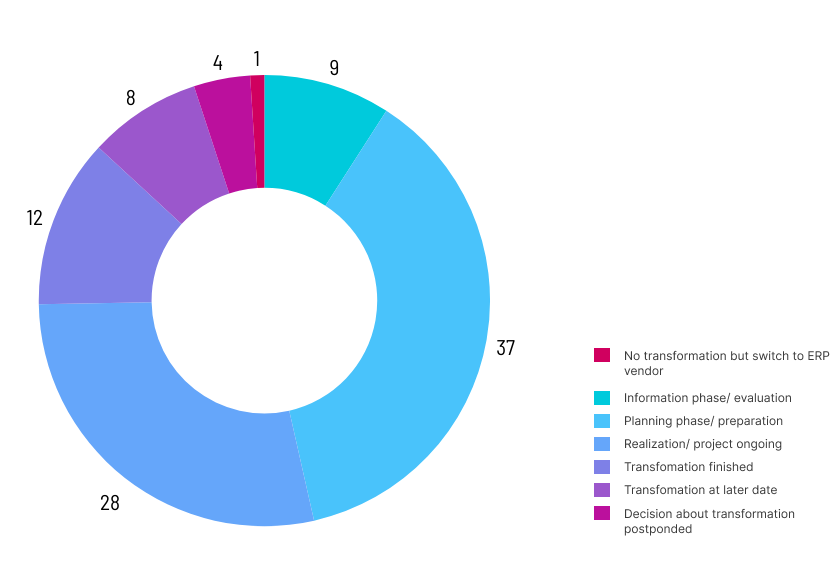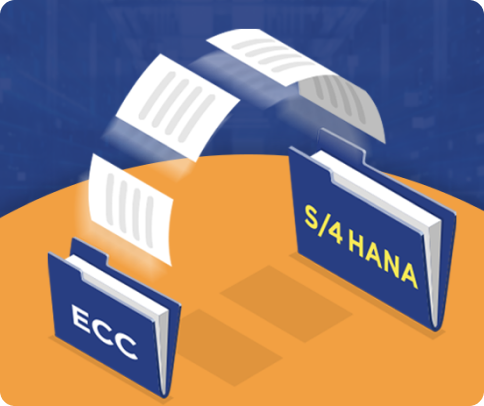Guide on SAP S/4HANA and how does it help the automotive industry?
Guide on SAP S/4HANA and how does it help the automotive industry?

Table of contents
Summary Points
| 01 | SAP has announced that by the end of 2027, SAP ECC will be going out of support and replaced by the next-generation SAP S/4HANA ERP solution. |
| 02 | Though the migration to SAP S/4HANA might not seem easy, businesses may often face challenges during this transition that includes lack of expertise, a lack of resource management, difficulty migrating to complex customisations, etc. |
| 03 | However, with proper planning and consideration, businesses can develop an effective migration plan, meticulously evaluate the current SAP ECC landscape, conduct a preparatory phase, a technical conversion phase, and undergo S/4HANA transformation. |
| 04 | In recent times, LeanIX and PwC conducted a study where different companies were asked about the SAP S/4HANA ERP system. 65% of those surveyed said that migration to SAP S/4HANA was a crucial part of the digital transformation strategy. |
Key Terms
AP ECC
SAP ECC stands for SAP Enterprise Resource Planning (ERP) Central Component. It’s one of the legacy applications that is designed to operate on third-party databases like Oracle, IBM DB2. SAP ECC is the core product within SAP Business Suite and helps large and mid-sized enterprises to manage their core business processes, resource tracking, and make data-driven decisions.
SAP ECC provides end-to-end integration of various business functions including finance, sales, procurement, manufacturing, CRM, and much more.
SAP S/4HANA
SAP S/4HANA is the latest version of SAP’s enterprise resource planning suite with built-in technologies including AI, Machine learning, and advanced analytics. SAP S/4HANA can be deployed on-premises or in the cloud environment that increases transparency of the operations, improves their performance and productivity, and accelerates decision-making. The SAP S/4HANA Cloud runs on the SAP HANA in-memory database.
SAP HANA
SAP (High Performance Analytic Appliance) is a multi-model database that stores data in its memory instead of storing it on a disk. SAP HANA is unique and significantly faster than other database management systems available in the market today. SAP HANA offers advanced search, analytics, and data integration capabilities for various types of data, structured and unstructured.
Fiori
SAP Fiori is replacement for SAP GUI. Fiori is a modern application that provides a user experience that you can customise across all business units, tasks, and devices.
SAP Fiori is a design system that helps us to create business apps with a consumer-grade user experience, turning casual users into proficient SAP practitioners through uncomplicated interfaces compatible with various devices. Some of the benefits of Fiori include enhances productivity, saves time where the time takes to complete the task is reduced to 64% when compared with SAP UI.
Data Migration
The process of transferring data from SAP ECC to SAP S/4HANA involves data extraction, transformation, and loading (ETL).
Trends and Forecasts

SAP ECC migration to SAP S/4 HANA
|
The need for SAP ECC to SAP/4HANA migration is certain, with SAP ECC going out of official support in 2027. With a lack of support for the legacy system, enterprises will likely experience severe bottlenecks across their workflows toward running their business seamlessly. Internal teams and resources would have to be allocated for the maintenance and management of the out-of-date systems and will have less flexibility in responding to changing trends of the industry and new business challenges. The diminishing returns from the application and lack of futureproofing, make the SAP ECC to SAP S/4HANA migration unavoidable for enterprises eventually. Waiting till the last moment for the data migration it leads to quality issues, business disruptions, etc. The early migration will enhance business efficiency. |
 |
STEPS IN SAP READINESS CHECK
 |
Familiarization with SAP S/4HANA To ensure a smooth transition from ECC TO S/4HANA, ECC users need to become familiar with the new system S/4HANA.This involves exploring the features, functionalities, modules, and workflows of S/4HANA. |
 |
Data Analysis and Classification The next critical step in migration is classifying the data based on three categories hot, warm, and cold.
|
 |
Data Cleansing Once the data is segregated the next crucial step is to refine the data and enhance the quality of it to ensure accuracy and reliability during migration. Some of the key processes involved in data cleansing are Duplicate Removal, Standardization, Validation, Enrichment, and Error Correction. |
 |
Readiness Check SAP Readiness Check is a tool designed to validate the system compatibility and readiness for specific SAP upgrades or migration. |
Challenges faced by the Automotive Industry
 |
Post industrial revolution, the automotive industry faces the biggest disruptions in technology. The digital age has evolved and brought new technologies like artificial intelligence, machine learning, real-time computing, e-mobility, autonomous driving etc. The more advanced the technology, the less the vehicular emissions.
Most of the automotive companies are bringing changes in hardware, software, and other business models. The automotive companies today need to focus more on research, development, and engineering. The other key challenge faced by them are fleet operations and transportation management. |
Why is SAP S/4 HANA imperative for the automotive industry?
To accommodate the future of mobility, the automotive industry will demand more advanced technologies. As automotive software is projected to reach USD 40.1 billion by 2027, companies can rely on SAP S/4 HANA for the below reasons:
Research, Development, and Engineering
It is more convenient to get your auto spare products with SAP S/4HANA since it empowers suppliers and manufacturers to communicate and collaborate faster, speed up product development, and stay compliant with automotive industry standards. It also helps you to
- Innovate better and provide timely resolutions to customer feedback.
- Global product safety management and compliance
- Right from R&D, manufacturing to aftermarket services, everything is synchronised and integrated.
- By leveraging in-memory computing, SAP S/4HANA enables faster data processing, enabling automotive manufacturers to make informed decisions and respond to changing market conditions.
- SAP S/4HANA’s advanced analytics capabilities allow automotive organisations to optimise production, inventory management, and supply chain operations, enhancing driving efficiency, minimising costs, and improving profitability.
Digital Supply Chain and Smart Manufacturing
The advent of SAP S/4HANA propels the automotive industry to new heights of productivity by integrating Industry 4.0 principles, enabling modular manufacturing and robust supply chain processes. The key features include:
- Adaptive and modular production systems.
- Track-and-trace capabilities for managing materials and work in progress within warehouses
- Production supply utilising driverless transport systems.
- Detection analysis and situational planning to mitigate supply network issues.
- Enablement of autonomous operations and self-optimised adaptive manufacturing.
Driving Sustainability
Automotive companies must create environmentally friendly electric vehicles, lead the decarbonisation movement, and stay competitive in the market and increase profitability. With SAP S/4HANA, automotive companies can work with recyclers to acquire the data they need to decide whether to recycle, reuse, or recover parts. This process eliminates waste and emissions.
- Simplify collaboration.
- Gain transparency on sustainably sourced and produced materials.
- Share best practices across the product lifecycle.
Sales and Marketing
SAP S/4HANA provides deeper insights, enabling automotive companies to make informed decisions based on customer market trends and customer behaviour.
- It automates the entire marketing process.
- Personalise the customer engagement.
- S/4HANA offers useful insights on internal sales and allows us to monitor the new sales order thereby increase revenue, improve personalization, and manage all product catalogs.
Case Studies of Automotive Companies on implementing SAP S/4HANA
BMW Group
BMW Group has had a longstanding partnership and collaboration with SAP for more than 30 years, and last year 2023 it has entered a new phase of its digital transformation journey by migrating to a digitised cloud architecture through SAP S/4HANA for its iFactory in Oxford, UK.
Audi
Audi focusses on smart manufacturing by implementing SAP S/4HANA.
Indus Motor
The Indus Motor Company made the decision to upgrade to SAP S/4HANA due its in-memory capabilities not offered by SAP’s competitors at the time, which allowed real-time reporting and data centralisation. The other benefits of the S/4HANA upgrade includes:
Quality management: Defects were identified immediately, saving a company $10,000 per minute in lost production.
Improved Materials Requirement Planning: The process of running the MRP (Materials requirement planning) takes four hours and now it takes 12 minutes and help in saving $250,000 annually.
Aurobay
Aurobay’s swift adoption of SAP S/4HANA post-separation from Volvo Cars, marks a significant milestone in Aurobay’s digital journey.
Goodyear
Goodyear, one of the world’s largest tyre companies, decided to leverage the latest SAP technologies to simplify and streamline their applications architecture to support business requirements.
Mahindra & Mahindra
Mahindra & Mahindra integrates SAP for efficient resource planning and coordination in the automotive manufacturing sector.
Conclusion
Infotel is at the forefront of digital transformation, actively embracing SAP S/4HANA to drive innovation and efficiency. Our commitment to leveraging cutting-edge technology ensures that we deliver exceptional value and stay ahead in the ever-evolving business landscape. By implementing SAP S/4HANA, we are not only improving our operational capabilities but also enabling our clients to achieve greater agility and streamlined processes.
Join us on this journey towards a smarter, more efficient future with SAP S/4HANA, and let Infotel be your trusted partner in achieving digital excellence.
 Infotel, là où vous êtes
Infotel, là où vous êtes
